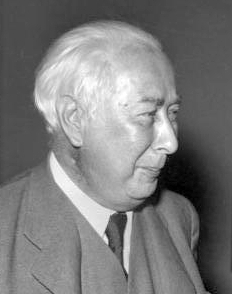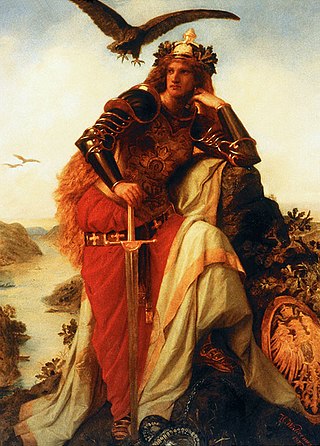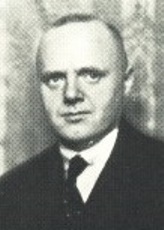Related Research Articles

The "Deutschlandlied", officially titled "Das Lied der Deutschen", has been the national anthem of Germany either wholly or in part since 1922, except for a seven-year gap following World War II in West Germany. In East Germany, the national anthem was "Auferstanden aus Ruinen" between 1949 and 1990.

"Auferstanden aus Ruinen" was the national anthem of the German Democratic Republic (GDR), often known informally as East Germany, during its existence from 1949 to 1990.

"La Borinqueña" is the official anthem of Puerto Rico.

The national anthem of Austria, also known by its incipit "Land der Berge, Land am Strome", was adopted in 1946. The melody, originally attributed to Wolfgang Amadeus Mozart but now disputed among various composers, was matched with a text by Paula von Preradović the following year.
A national anthem is a patriotic musical composition symbolizing and evoking eulogies of the history and traditions of a country or nation. The majority of national anthems are marches or hymns in style. American, Central Asian, and European nations tend towards more ornate and operatic pieces, while those in the Middle East, Oceania, Africa, and the Caribbean use a more simplistic fanfare. Some countries that are devolved into multiple constituent states have their own official musical compositions for them ; their constituencies' songs are sometimes referred to as national anthems even though they are not sovereign states.

The "Swiss Psalm" is the national anthem of Switzerland.

Theodor Heuss was a German liberal politician who served as the first president of West Germany from 1949 to 1959. His cordial nature – something of a contrast to the stern character of chancellor Konrad Adenauer – largely contributed to the stabilization of democracy in West Germany during the Wirtschaftswunder years. Before beginning his career as a politician, Heuss had been a political journalist.

"Die Wacht am Rhein" is a German patriotic anthem. The song's origins are rooted in the historical French–German enmity, and it was particularly popular in Germany during the Franco-Prussian War and the First World War. The original poem was written by Max Schneckenburger during the Rhine crisis of 1840, and is generally sung to music written by Karl Wilhelm in 1854, seven years after Schneckenburger's death.

"Gott erhalte Franz den Kaiser" was a personal anthem to Francis II, Emperor of the Holy Roman Empire and later of the Austrian Empire, with lyrics by Lorenz Leopold Haschka (1749–1827) and music by Joseph Haydn. It is sometimes called the "Kaiserhymne". Haydn's tune has since been widely employed in other contexts: in works of classical music, in Christian hymns, in alma maters, and as the tune of the "Deutschlandlied", the national anthem of Germany.

The Liberal Democratic Party of Germany was a political party in East Germany. Like the other allied bloc parties of the Socialist Unity Party of Germany (SED) in the National Front, it had 52 representatives in the People's Chamber.

"Qaumī Tarānāh", also known as "Pāk Sarzamīn", is the national anthem of the Islamic Republic of Pakistan and formerly the Dominion of Pakistan. It was written in Urdu by Hafeez Jalandhari in 1952 and the music was composed by Ahmad G. Chagla in 1949, preceding the lyrics. It was broadcast publicly for the first time on Radio Pakistan on 13 August 1954, sung by Jalandhari himself and officially adopted on 16 August 1954 by the Interior Ministry of the Government of Pakistan.
Nazi songs are songs and marches created by the Nazi Party. In modern Germany, the public singing or performing of songs exclusively associated with the Nazi Party is now illegal.

"Für Danzig" was the official national anthem of the Free City of Danzig from 1920 to 1939. The lyrics were written by Paul Enderling, while the music was by Georg Göhler. After the invasion of Poland and the concurrent annexation of Danzig by Nazi Germany in 1939, Deutschlandlied was adopted as the official anthem, along with the Horst-Wessel-Lied.

"Ich hab mich ergeben", originally titled "Gelübde" ("Vow"), is a German patriotic song. The text was written in 1820 by Hans Ferdinand Maßmann. It was one of the unofficial national anthems of West Germany from 1949 to 1952, when the "Deutschlandlied" was officially reinstated. Its tune is now used in the Micronesian national anthem.

Elisabeth Eleonore Anna Justine Heuss-Knapp was a German politician of the Free Democratic Party (FDP), social reformer, author and wife of German president Theodor Heuss. She was the founder of the Müttergenesungswerk charitable organisation officially called Elly Heuss-Knapp Foundation in her honour.
"Kinderhymne" is a poem by Bertolt Brecht, written in 1950 and set to music by Hanns Eisler in the same year.
"Sei gesegnet ohne Ende", also known as the ″Kernstock-Hymne″, is a German language song that was the national anthem of Austria from 1929 until 1938. Written by Ottokar Kernstock, it was sung to the famous tune of "Gott erhalte Franz den Kaiser" by Joseph Haydn, better known as the tune of the "Deutschlandlied", which since 1922 has been the national anthem of Germany.

Rudolf Alexander Schröder was a German translator and poet. In 1962 he was awarded the Johann-Heinrich-Voß-Preis für Übersetzung. He was nominated for the Nobel Prize in Literature five times.
Hermann Reutter was a German composer and pianist who worked as an academic teacher, university administrator, recitalist, and accompanist. He composed several operas, orchestral works, and chamber music, and especially many lieder, setting poems by authors writing in German, Russian, Spanish, Icelandic, English, and ancient Egyptian and Greek, among others.
Mein Waldeck is a German patriotic song and was the anthem of the Waldeck between 1879 and 1929 when Waldeck joined Prussia.
References
- ↑ Celia Applegate (ed.), Music and German National Identity, The University of Chicago Press, 2002, p. 262.
- ↑ "West Germany (1950-1952) – nationalanthems.info".
- ↑ Peter Reichel, Schwarz-Rot-Gold: kleine Geschichte deutscher Nationalsymbole nach 1945, p. 41/42.